It should come as no surprise that working on cars for fun places special demands on tools. Or at least, on the type of tools you need. You see, many automotive tools simply aren’t found at the local hardware or home improvement store. As enthusiasts, we’re dealing with things that many of those shops know, understand or even care little about. In addition, we’re often dealing with some very specialized applications. The only way to handle it is with the right equipment.
Because of that, we’ve picked 10 tools from our personal tool collection that we believe enthusiasts can’t work without. These pieces of car care equipment aren’t based on earth-shattering technology, but they do rank right up there in the “can’t do without ’em” bracket. And by the way, this certainly isn’t an all-inclusive list of neat tools – it’s just a list of items we have on hand and have personally found beneficial. You probably will, too. These tools definitely make wrenching easier (and simultaneously make your work more accurate).
 1. Air compressor
1. Air compressor
A quality shop air compressor is, at least in our opinion, the cornerstone of a great automotive tool collection. Sure it can perform menial tasks such as blowing up a tire or providing compressed air to blow the cobwebs off old parts, but those aside, it’s the brute force required to do all sorts of jobs from powering air tools to powering paint guns. When it comes to compressors, buy the best and the biggest you can afford. Just be sure you have sufficient electrical capability to run it (usually a 5.5-hp single phase electric motor coupled to a compound compressor is the maximum a home electrical panel can handle).
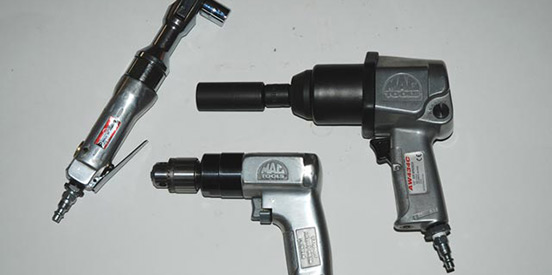 2. Air tools
2. Air tools
Are air tools a luxury? You might think so until you need them, particularly when it comes to working on heavy-duty hardware like suspension components. You see, suspension bits regularly use large diameter nuts and bolts. Out of necessity, they usually have high torque figures. That means lots of muscle power is required to remove and replace them (you might be surprised at how much force is really required).
But there’s more: Suspension bits live in a harsh environment. That makes the fasteners even more difficult to deal with. The solution is air. A half-inch and/or a three-eighths-inch impact wrench can turn a chore into a cakewalk. So can an air-powered three-eighths-inch ratchet. Ditto with air-powered drills. By the way, good air tools are lighter, much more compact, and considerably more powerful than their electric cousins. Once you get hooked on air tools, you’ll wonder how you lived without them.
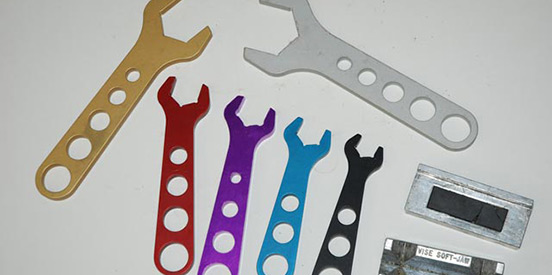 3. Aluminum AN wrenches and vice-jaw inserts
3. Aluminum AN wrenches and vice-jaw inserts
AN hose and fittings are definitely the way to plumb a car. That’s a given. But one of the real knocks on those shiny anodized aluminum aircraft fittings is that they can easily be damaged by the use of standard steel hand tools. Now, we’ve tried all of the so-called “fixes” when working with these fittings, but the real solution is to use the right tools.
Several manufacturers offer a complete set of sturdy anodized aluminum wrenches designed to fit the hexes and to minimize the marking on hose ends. When shopping for aluminum AN wrenches, beware: Some brands of wrenches are rather flimsy. As a result, they deflect when used. These tools are sold in a set that ranges from -6 through -20. Finally, the wrenches are color-coded by size so that you can find them quickly in your toolbox.
Aeroquip’s vice-jaw inserts are an absolute must if you have any AN fittings on your car. The inserts firmly hold the hex of the fitting during assembly (or disassembly) without marring the anodized finish of the fittings. The inserts are manufactured from aluminum and have angled pockets, which allows them to be used with any fitting from -3 to -32. A horizontal pocket on the length of the vise-jaws is ideal for holding steel braided hose in place during cutting operations. Finally, the inserts are designed with magnetic backs that allow quick setups and easy transfer between vises (you don’t need a dedicated “hose vise”). As far as we’re concerned, this is a must-have enthusiast tool.
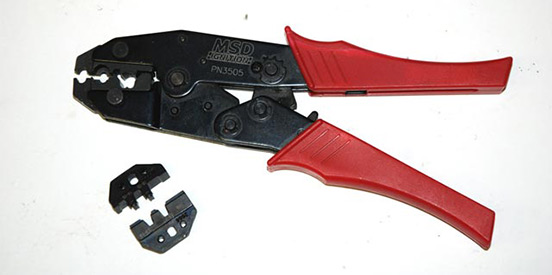 4. Pro crimp tool
4. Pro crimp tool
If there is a downside to today’s latest spiral wound suppression wires, it’s the aggravation of properly terminating the wire and crimping the ends. There are several tools available to accomplish this task, but we’ve developed a fondness for MSD’s pro crimp tool. It’s a beefy steel piece that isn’t plagued with handle flex. The main frame is built from hardened steel, and it incorporates comfortable molded handgrips. Just as important, it’s engineered to painlessly crimp today’s spiral wound ignition wire. There are several different types of interchangeable jaws available for stripping and crimping (you simply swap the jaws for the type of work you’re doing). The best part, however, is that it crimps wire by way of a ratchet action that provides secure, factory-style crimps. In simple terms, once you’ve lined up the respective pieces and squeeze down on the handles, you’re guaranteed a perfect crimp. The bottom line: There’s no guesswork. And that’s something any enthusiast can appreciate.
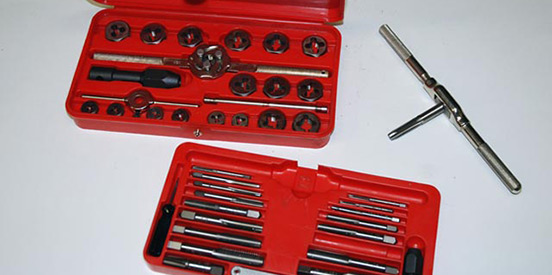 5. Tap and die sets
5. Tap and die sets
No one likes stripped threads. It’s no fun on any car, let alone one you have to really depend upon. The answer, of course, is a tap and die set. Get an inexpensive tap and die set and you’re done. Right? Maybe not. Cheap sets are just that. Handles break and, in a worst-case scenario, the tap can break. Then you have real grief. The truth is, you should add a quality tap and die set to your toolbox. Better still, buy an SAE “fractional” set along with a metric set. You’ll appreciate them.
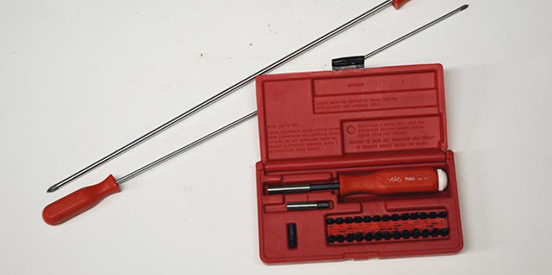 6. Specialty screwdrivers
6. Specialty screwdrivers
Once upon a time an enthusiast could get by with a couple of flat-blade screwdrivers and a Phillips or two. Not so today. Cars are filled with all sorts of specialty screw heads. And you need the right tool for the job. You can use a universal magnetic screwdriver (where the tips are easily interchanged) or you can use dedicated screwdrivers. For the most part, it’s best to have both. This way, the most common screwdrivers are stand-alone, dedicated models while the others are contained in a replaceable tip assortment.
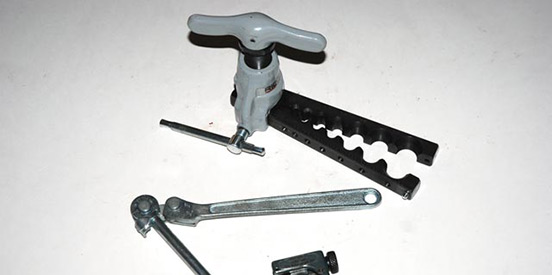 7. Hard line tools
7. Hard line tools
Not really one tool, but three, these are tools you’ve seen before on these pages. Included are a Rigid flaring tool, an Eastman bending tool and a Rigid mini-tubing cutter. Without these three tools, it’s almost impossible to cut, bend and flare hard line (particularly stainless steel). While there are other similar tools available, we’ve found the quality of these pieces to be absolutely top notch. They do their job (and make us look like we really know what we’re doing), don’t break, and turn out beautiful work consistently. Unfortunately, these aren’t the least expensive tubing tools available. We found ours at a local auto parts warehouse distributor that was basically changing its focus from mechanical tools and parts to safety equipment. As a result, they weren’t quite as costly. Shop around for them, but remember to specify tools specifically designed for stainless. Otherwise, you’ll just be wasting your time.
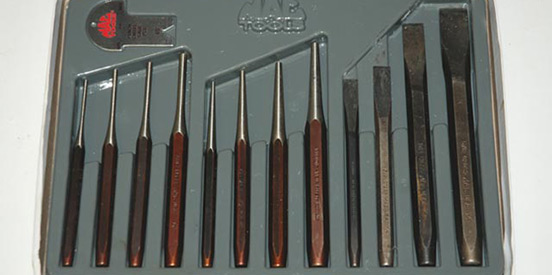 8. Punch and chisel set
8. Punch and chisel set
A comprehensive high-quality punch and chisel set is something you won’t regret having. One of the first things we noticed when we examined this punch and chisel set from Mac Tools is the actual sharpness of the chisels. Many jobber chisels are, to put it mildly, blunt instruments. It takes considerable pounding on a poorly designed chisel to get the job done. With a high-quality chisel, the tool does the work, not the hammer. Add a set of safety goggles to your wish list. And don’t take safety goggles lightly, particularly when using a hammer and chisel. Stuff in your eyes is never fun.
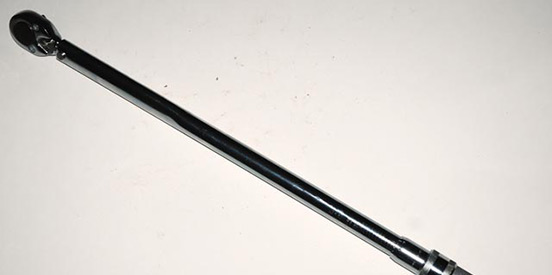 9. Torque wrench
9. Torque wrench
One tool that you’ll absolutely need when working on a car is a torque wrench. There are a number of different configurations available (beam, “clicker,” dial, etc.), along with a large number of ranges including inch-pounds, foot-pounds and metric. You’ll also find that torque wrenches can be purchased in any number of socket drive sizes (quarter-inch, three-eighths-inch, half-inch and three-quarter-inch are the most common). For a starter tool collection, you can’t go wrong with a half-inch drive wrench of the “clicker” variety. Mac Tools calls this a “Micrometer Adjustable Torque Wrench,” and it’s designed to signal you by way of sound and impulse when the desired setting is reached. A torque wrench that falls between 50 and 250 foot-pounds will likely cover the most-used ranges for beginning enthusiasts.
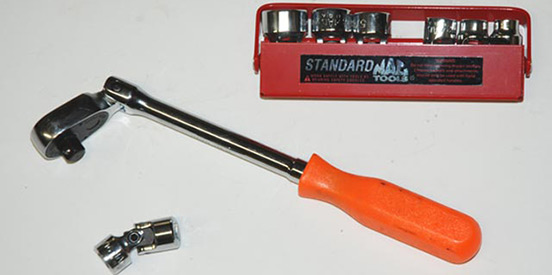 10. Ratchet and short U-joint sockets
10. Ratchet and short U-joint sockets
Have you ever had a nut or bolt that you swear is impossible to reach? If so, you might want to look at this: It’s a three-eighths-inch drive “Spinflex” ratchet from Mac Tools. This ratchet uses Mac’s patented configuration that includes a 180-degree flex joint pivot. This allows you to get into tight spots where a standard ratchet won’t fit. It’s absolutely perfect for things like changing spark plugs, reaching tight bell housing bolts and so on. There’s more here too: See the sockets? They’re short universal joint sockets. The small overall length coupled with the shallow socket depth makes them perfect for reaching tight spots.
Source: Mobileoil
